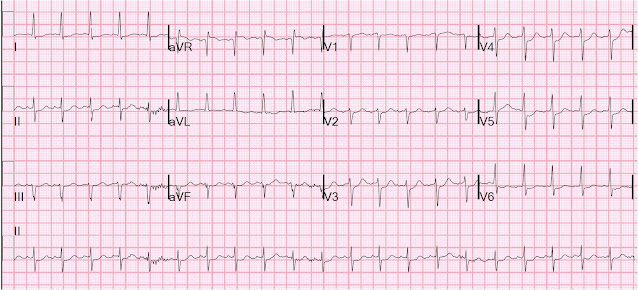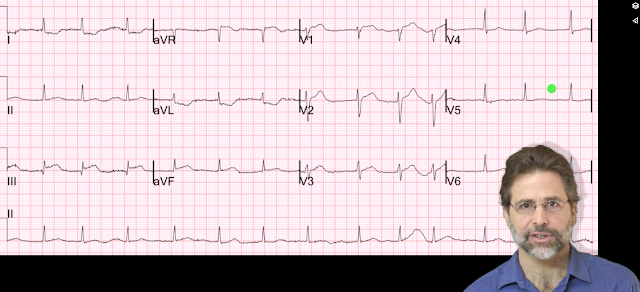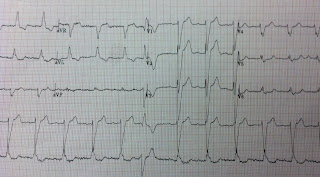These 4 recent cases illustrate acute and subacute MI with reperfusion and absence of reperfusion (or failed reperfusion).
QS-waves and
depth of T-wave inversion are very helpful in determining the duration of injury
(the "acuteness" of the ECG), the viability of the myocardium, and patency of the infarct-related artery.
Persistence of ST elevation helps to determine state of the myocardium after reperfusion.
Definition: total loss of R-wave means there is a QS-wave (a single deep deflection). Preservation of R-wave may mean and initial Q-wave followed by an R-wave (this is called a QR-wave. Upper case vs. lower case Q (q) or R (r) is used to designate smaller or larger waves.
1. This 57 yo diabetic male presented with generalized fatigue, myalgias, and arthralgias, mild subjective fever and chills, and nausea. He also stated his arms and head feel "heavy" and he had a headache, dry heaves, and dizziness, and some "indigestion" in his chest "like acid". His pulse was 114. Exam was otherwise normal.
 |
| There are QS-waves in precordial leads with some preserved R-wave in V2 (Qr-wave). There is persistent ST elevation, but no T-wave inversion. T-waves are not tall (tall, hyperacute T-waves are markers of ischemic but viable myocardium). The fact that they are not present here suggests that the MI is complete. That they are not inverted tells us that the artery is still closed. But the presence of a bit of R-wave gives some hope that there might be some viable myocardium left. [STE in lateral leads, with inferior reciprocal ST depression, tells us it is a proximal LAD ] |
Cath showed a 100% proximal LAD and other disease. It was opened. Initial troponin I was > 50 ng/ml; followups are not available. Echo on the day after admission showed EF of 30-35% and antero-apical wall akinesis with an LV thrombus [these frequently form in complete or near complete (no early reperfusion) anterior STEMI because of akinesis/stasis]
2 more days later, this was recorded:
 |
| ST elevation is still present. Persistent ST elevation 3 days after a nearly transmural MI portends possible LV aneurysm. |
Echo at this time showed some improvement in EF to 40%, but persistent akinesis and thrombus.
2. This 42 yo diabetic male presented with cough and foot pain. He had been awakened by cough at 3 AM 2 days earlier. In spite of aggressive questioning, he denied chest pain, but he did tell one triage nurse that he had had some chest burning, and so he underwent an ECG:
 |
| There are deep Q-waves and QS-waves in precordial leads V2-V3, with a bit of R-wave left in V4. ST segments are greatly elevated and T-waves are deeply inverted. There is also T inversion in I and aVL (Proximal LAD) and a Q-wave in III. |
Symptoms have been prolonged but intermittent, and there has been little chest pain, if any.
So all duration of injury must be estimated from the ECG.
Even when there is chest pain, the ECG is a more reliable indicator of injury duration than are symptoms. Here there are some QS-waves, telling us that there has probably been a significant amount of completed infarction, but there is also persistent R-wave in lead V4 suggesting some viable myocardium.
The deep T-wave inversion also tells us that there is a significant amount of viable myocardium left and that the artery is most likely open.
It is very unlikely to be LV aneurysm morphology when the ST elevation is so high and the T-Wave inversion is so deep.
Cath showed a 95% LAD with flow. Echo showed anterior wall motion abnormality. Peak troponin I was 52 ng/ml (significant myocardial loss, but not the whole anterior wall)
3. This 67 yo male with h/o HTN and GERD only presented with 60 minutes of diaphoresis and GERD symptoms. He had a prehospital ECG:
 |
| Obvious anterolateral acute STEMI |
The patient received aspirin only and his pain immediately resolved:
 |
| Clear resolution of all ST elevation, with only some residual T-wave inversion in I and aVL. The LAD has reperfused early. |
An open 90% LAD was stented. Peak troponin I was 0.3, so almost no myocardium was lost.
Here is the ECG the next AM:
 |
| There was so little infarction that there are lateral, but no anterior reperfusion T-waves (normally, there would be Wellens' type waves after LAD reperfusion). The T-waves are smaller than they were immediately after reperfusion, illustrating how hyperacute T-waves are present BOTH shortly after occlusion (when ST segments are on the way up) and shortly after reperfusion (when ST segments are on the way down). |
4. A 51 year old male with h/o stent presented with 30 minutes of chest pain:
 |
| Obvious anterolateral very acute STEMI with hyperacute T-waves |
He went for immediate PCI, with successful reperfusion of a 100% occluded proximal LAD, and a
door to balloon time of 35 minutes. This was recorded 2.5 hours later, after PCI:
 |
| There is a significant QS-wave in V2, with some persistent ST elevation, suggesting incomplete small vessel reperfusion and significant infarction. |
The patient continued to have ischemia after PCI, and in fact had an episode of polymorphic VT shortly after while in the ICU. This was recorded the next AM:
 |
| There are QS-waves in V2 and V3, with rather shallow T-wave inversion, both indicative of significant myocardial loss. |
Peak troponin I was 84 ng/ml and there was a large anterior wall motion abnormality, in spite of very fast treatment and a symptom onset to balloon time of 65 minutes.
Sometimes, even with very fast reperfusion, there is significant myocardial loss because of downstream obstruction of small vessels. This can be seen on angiogram as an absence of "myocardial blush" and is measured the the TIMI myocardial perfusion grade (TMP grades 0-3, just like TIMI flow grades 0-3).
As it turns out, the best measure of reperfusion is TMP (not TIMI flow) and the best noninvasive measure of TMP is the ECG, as measured by resolution of ST elevation on the ECG ("ST resolution"), with 70% resolution associated with high TMP grade.
The ECG, as it turns out, is the best predictor, better the TMP grade because TMP measures microvascular patency, and the ECG measures cellular viability (
see this full text article and
this abstract).
I will specifically discuss acuteness on the ECG in a future post.
Here is some older but very interesting literature on TIMI myocardial perfusion grade and ST resolution:
1. Claeys MJ, Bosmans J, Veenstra L, et al. Determinants and prognostic implications of persistent ST-segment elevation after primary angioplasty for acute myocardial infarction: importance of microvascular reperfusion injury on clinical outcome. Circulation 1999;99(15):1972-7.
2. Gibson CM, Cannon CP, Murphy SA, et al. Relationship of TIMI myocardial perfusion grade to mortality after administration of thrombolytic drugs. Circulation 2000;101(2):125-30.
3. Shah A, Wagner GS, O'Connor CM, et al. Prognostic implications of TIMI flow grade in the infarct related artery compared with continuous 12-lead ST-segment resolution analysis. Reexamining the "gold standard" for myocardial reperfusion treatment. J Am Coll Cardiol 2000;35(3):666-72.
4. van't Hof AW, Liem A, de Boer MJ, et al. Clinical value of 12-lead electrocardiogram after successful reperfusion therapy for acute myocardial infarction. Zwolle Myocardial Infarction Study Group. Lancet 1997;350(9078):615-9.
5. van't Hof AW, Liem A, Suryapranata H, et al. Angiographic assessment of myocardial reperfusion in patients treated with primary angioplasty for acute myocardial infarction: myocardial blush grade. Zwolle Myocardial Infarction Study Group. Circulation 1998;97(23):2303-6.






















































